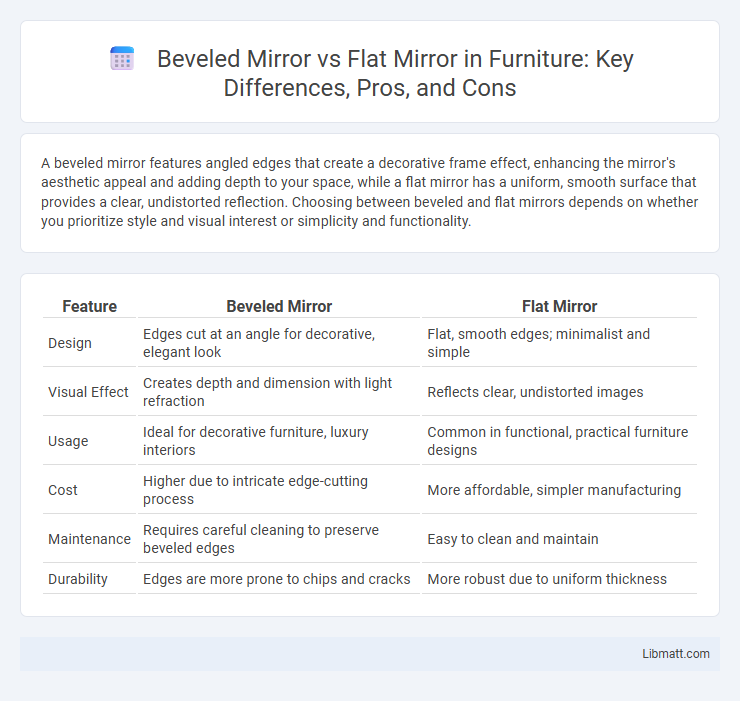A beveled mirror features angled edges that create a decorative frame effect, enhancing the mirror's aesthetic appeal and adding depth to your space, while a flat mirror has a uniform, smooth surface that provides a clear, undistorted reflection. Choosing between beveled and flat mirrors depends on whether you prioritize style and visual interest or simplicity and functionality.
Table of Comparison
| Feature | Beveled Mirror | Flat Mirror |
|---|---|---|
| Design | Edges cut at an angle for decorative, elegant look | Flat, smooth edges; minimalist and simple |
| Visual Effect | Creates depth and dimension with light refraction | Reflects clear, undistorted images |
| Usage | Ideal for decorative furniture, luxury interiors | Common in functional, practical furniture designs |
| Cost | Higher due to intricate edge-cutting process | More affordable, simpler manufacturing |
| Maintenance | Requires careful cleaning to preserve beveled edges | Easy to clean and maintain |
| Durability | Edges are more prone to chips and cracks | More robust due to uniform thickness |
Introduction to Beveled and Flat Mirrors
Beveled mirrors feature edges that are cut and angled, creating a decorative frame that enhances the mirror's visual depth and elegance, while flat mirrors have smooth, uniform surfaces without any edge treatment. The beveled edge refracts light differently, adding dimension and a sophisticated touch to your space, whereas flat mirrors provide a sleek, modern, and minimalist look that fits seamlessly in various interior styles. Choosing between beveled and flat mirrors depends on your design preference and the ambiance you want to achieve in your room.
Defining Beveled Mirrors
Beveled mirrors feature edges cut at an angle to create a framed, decorative effect that enhances depth and light reflection in a space. Unlike flat mirrors with smooth, straight edges, beveled mirrors add a sophisticated, dimensional look, often used in interior design to elevate aesthetic appeal. Your choice between beveled and flat mirrors depends on whether you prioritize elegance and texture or a minimalist, clean appearance.
What Are Flat Mirrors?
Flat mirrors feature a smooth, flat reflective surface that preserves the true proportions and dimensions of objects without distortion. These mirrors reflect light directly, producing a clear, accurate image ideal for daily use in bathrooms, bedrooms, and dressing areas. Your choice of a flat mirror ensures consistent visual clarity and true representation of your appearance or surroundings.
Visual Appeal and Aesthetics
Beveled mirrors feature angled edges that create a decorative frame effect, enhancing visual appeal by adding depth and dimension to a space. Flat mirrors offer a sleek, minimalist look that complements modern and contemporary interiors without distracting from other design elements. The subtle play of light on beveled edges provides a sophisticated aesthetic, while flat mirrors maintain a clean, unobtrusive profile.
Functional Differences
Beveled mirrors feature angled edges that enhance light reflection and add depth to a space, creating a more decorative and dimensional appearance compared to flat mirrors. Flat mirrors provide an undistorted, accurate reflection ideal for functional uses such as grooming and interior design requiring precision. The beveled edges can also soften the transition between the mirror and the wall, while flat mirrors offer a clean, straightforward viewing surface without ornamental effects.
Durability and Maintenance
Beveled mirrors feature angled edges that are more prone to chipping and require careful handling, while flat mirrors typically offer enhanced durability due to their uniform edges. Maintenance for beveled mirrors involves gentle cleaning to preserve their decorative edges, whereas flat mirrors can withstand more robust cleaning methods without damage. Your choice should consider whether you value the aesthetic appeal of beveled edges or the practical durability of flat mirrors.
Installation and Placement Considerations
Beveled mirrors require precise installation to ensure the angled edges align properly with surrounding decor, often demanding professional handling to avoid damage. Flat mirrors offer more straightforward mounting options and can be placed in various settings without concern for edge orientation. Placement of beveled mirrors is ideal in areas where the frame effect enhances visual appeal, while flat mirrors suit functional spaces needing clear, undistorted reflections.
Cost Comparison
Beveled mirrors generally have a higher cost compared to flat mirrors due to the additional labor and precision required to create the angled edges. Flat mirrors are more affordable and widely available because they involve straightforward manufacturing processes without decorative detailing. The price difference can range from 20% to 50%, depending on the size and quality of the beveled edge.
Best Uses for Beveled Mirrors
Beveled mirrors enhance any space by adding depth and a touch of elegance, making them ideal for decorative accents in living rooms, bathrooms, and entryways. Their angled edges create a subtle frame effect that highlights architectural details and enhances natural light reflection, elevating your interior design. Choose beveled mirrors for areas where style and sophistication are prioritized over straightforward reflection.
Ideal Applications for Flat Mirrors
Flat mirrors are ideal for applications requiring accurate and undistorted reflections, such as personal grooming, makeup application, and interior design settings where true-to-life image representation is crucial. They are extensively used in bathrooms, dressing rooms, and retail stores to provide precise visual feedback without distortion. Flat mirrors enhance spatial perception and lighting in residential and commercial environments by reflecting light evenly and maintaining proportional dimensions.
Beveled mirror vs flat mirror Infographic

 libmatt.com
libmatt.com